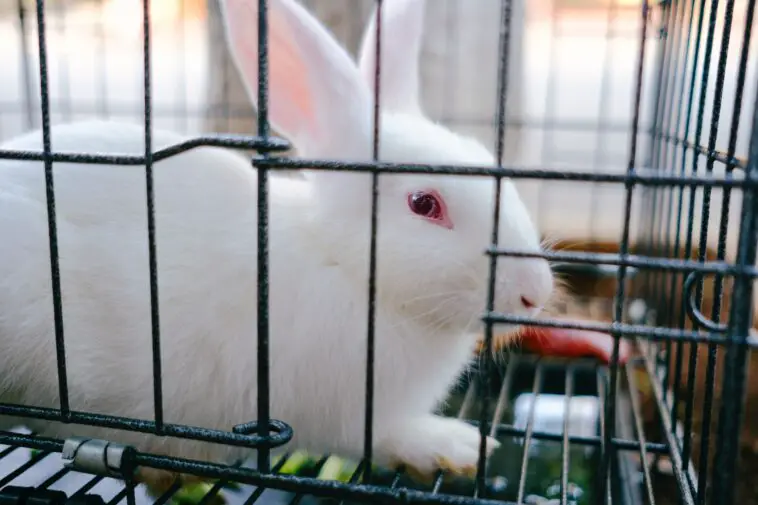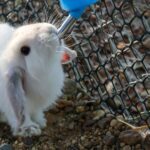Pine pellets are a compressed biomass fuel made from pine wood fibers that have gained popularity as an alternative to traditional fossil fuels. However, these pellets also have a variety of other uses, including as a bedding material for rabbits.
Pine pellets are popular due to their absorbency and odor-control properties. When the pellets come into contact with urine, they expand and break down into sawdust, creating soft, absorbent bedding that is easy to clean and replace.
However, there are concerns about the potential health risks associated with using pine pellets as a bedding material for rabbits. This article will examine these concerns in more detail and guide using pine pellets safely and effectively. We will also explore the benefits and potential drawbacks of using pine pellets as a bedding option for rabbits.
Composition and Production of Pine Pellets
According to World Export, pine pellets for animal bedding are produced from wood waste from agricultural or forestry activities. To make these pellets, the raw materials are inspected, screened, and cleaned before being compressed and cooled to create the final product.
Moreover, pine pellets are a type of biomass fuel made from compressed pine wood fibers. They are created by grinding and compressing sawdust and shavings left over from the production of lumber and other wood products.
During this process, the wood fibers are compressed under high pressure, which removes any moisture and creates a high-density material that can be easily transported and burned as fuel.
The production of pine pellets begins with the collection of pine wood waste, which is then ground into a fine sawdust using a hammer mill or similar machine. This sawdust is then fed into a pellet mill, which is compressed under high pressure and heat to create small, uniform pellets. The pellets are then cooled and packaged for distribution and use.
The composition of pine pellets is typically around 80-90% softwood, primarily pine, with the remaining 10-20% consisting of binders and additives such as lignin and wax. These binders help hold the pellets together during production and improve their quality and burn characteristics. The resulting pellets are a renewable energy source that can be a more sustainable alternative to traditional fossil fuels.
Advantages of Using Pine Pellets
Pine pellets as a bedding material for rabbits offer several advantages, making them a popular choice among pet owners. Here are some of the advantages of using pine pellets for rabbit bedding:
Absorbency
Pine pellets are highly absorbent and can absorb several times their weight in liquid. This makes them an effective choice for managing rabbit urine and keeping their living space dry and comfortable.
Odor control
The pellets’ natural pine scent helps control odors in the rabbit’s living space, making it more pleasant for the rabbit and its owner.
Dust-free
Pine pellets are less dusty than other bedding materials, such as straw or hay. This can help to reduce respiratory issues in rabbits and their owners.
Eco-friendly
Pine pellets are made from renewable resources and can be composted or used as garden mulch. This makes them an environmentally friendly option for rabbit bedding.
Convenience
Pine pellets are widely available in pet stores and online, making them convenient for many rabbit owners.
Disadvantages of Using Pine Pellets
Some potential disadvantages should be considered. Here are some of the most common disadvantages of using pine pellets for rabbit bedding.
Cost
Pine pellets can be more expensive than other bedding materials, such as straw or hay. This can make them less accessible to rabbit owners on a tight budget.
Storage
Pine pellets should be stored in a dry location to prevent them from becoming unusable. This can be challenging for owners with limited storage space or who live in humid environments.
Litter training
Some rabbits may not use pine pellets as a litter box right away. They require additional training or encouragement to use them effectively.
Availability
While pine pellets are widely available in pet stores and online, they may not be less readily available in some areas. That is why this can be difficult for some owners to obtain.
Comparison of Pine Pellets to Other Common Bedding Materials for Rabbits
Let’s take a closer look at the comparison between pine pellets and other common bedding materials for rabbits:
Straw
Straw is a popular bedding material for rabbits because it is widely available and inexpensive. However, straw is less absorbent than pine pellets and may require more frequent changes to keep the rabbit’s living space clean. Straw also tends to be dusty, which can cause respiratory problems for rabbits and their owners.
Hay
Hay is another common rabbit bedding material but is less absorbent than pine pellets. Hay can be messy and difficult to clean and may not control odors or pine pellets. Additionally, hay can be dusty, which can cause respiratory problems for rabbits.
Shavings
Wood shavings, such as aspen, are another popular rabbit bedding material. They are absorbent and help control odors, but they can be dusty and cause respiratory problems in some rabbits. In addition, cedar shavings, particularly, have been known to cause liver damage in rabbits and should be avoided.
Paper-based bedding
Some rabbit owners opt for paper-based bedding, such as shredded newspaper or paper pulp. This type of bedding is absorbent and easy to change, but it can be messy and may not control odors or pine pellets. Paper-based bedding may also contain links or chemicals that can harm rabbits.
However, each type of bedding material has pros and cons, and rabbit owners should consider their needs and preferences when selecting a bedding material for their rabbit.
Read more: How To Choose The Best Beddings For Rabbits
Potential Health Risks of Using Pine Pellets
While pine pellets can be a suitable and convenient bedding material for rabbits, some potential health risks are associated with their use. Here are some of the main concerns:
Respiratory irritation
Pine pellets contain aromatic oils that can cause respiratory irritation in rabbits, particularly if they are sensitive to the scent. This can lead to coughing, sneezing, and other respiratory symptoms. It is important to ensure the rabbit’s living space is well-ventilated and monitor for any signs of respiratory distress.
Pine oil toxicity
Pine oil, which is present in pine pellets, can be toxic to rabbits if ingested in large quantities. While this is unlikely to occur through the normal use of pine pellets as bedding, it is important to keep the pellets away from the rabbit’s food and water sources and to monitor for any signs of ingestion.
Allergic reactions
Some rabbits may be allergic to pine pellets, which can cause skin irritation, itching, and other allergic symptoms. ISwitching to a different bedding material is important if the rabbit exhibits any signs of an allergic reaction.
Dust
While pine pellets are generally less dusty than some other bedding materials, they can still create dust that can irritate a rabbit’s respiratory system. Regular cleaning and maintenance of the rabbit’s living space can help reduce the amount of dust.
It is important to be aware of potential health risks and closely monitor your rabbit’s health. It is always best to consult a veterinarian if you have any concerns.
How to Clean and Maintain Pine Pellets as Bedding Material
Cleaning and maintaining pine pellets as bedding material for rabbits is important to ensure your rabbit has a clean and healthy environment. Here are some steps to clean and maintain pine pellets as bedding material for rabbits:
Step 1. Scoop out any soiled pine pellets daily using a litter scoop.
Step 2. Remove the used pine pellets every few days and replace them with fresh ones.
Step 3. Use a pet-safe disinfectant to clean the litter box and surrounding area.
Step 4. Dry the litter box and surrounding area thoroughly before adding fresh pine pellets.
Step 5. Check the litter box and surrounding area regularly for any signs of dampness or mold.
Step 6. If you notice any dampness or mold, replace the affected pine pellets with fresh ones.
Step 7. Store the remaining pine pellets in a cool, dry place to prevent them from getting damp or moldy.
Key Takeaways
- Pine pellets are a type of biomass fuel made from compressed pine wood fibers.
- Pine pellets as a bedding material for rabbits offer several benefits, including absorbency, odor control, reduced dust, and eco-friendliness.
- Using pine pellets as a bedding material for rabbits has many benefits, but there are also some potential drawbacks, including dust, cost, storage, litter training, and availability.
- Pine pellets offer several advantages for rabbit owners. They are highly absorbent, help control odors, and are less dusty than other materials.
- Be aware of the potential health risks associated with using pine pellets. Potential health risks include respiratory irritation, pine oil toxicity, allergic reaction, and dust.
- Following particular steps, you can ensure that your pine pellets are properly cleaned and maintained as a safe and healthy bedding material for your rabbit.


